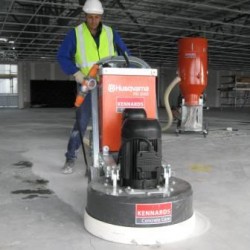Sealed Concrete Floor: Problem for New Floor Installation?
Laying some types of finish flooring straight atop concrete slab has its ups and its downs. Most concrete is in fairly level condition–after all, it’s a quasi-liquidfied substance that is largely self-leveling. But one problem you’ll often run into is sealed concrete.
It may seem that sealed concrete is a perfect surface to lay down finish flooring. What could be cleaner and less porous than concrete with sealant on it?
Well, as it turns out, sealed concrete is not the best surface…
Find Out – Is the Concrete Sealed?
Dip your fingers in a cup of water and sprinkle some drops onto the concrete slab. Does the water bead up? If so, it could be that the concrete is impregnated with oil or some other substance that repels water–in which case you still need to thoroughly clean the thing.
But if water beads up all around the flooring, you’ll know it’s been sealed.
How to Remove Concrete Sealant

Your finish flooring adhesives actually need a porous surface in order to bond well; slick does not do the job. There is no substance that I know of that will allow you to blister and peel/scrape away concrete sealant, in the manner that you might strip paint from woodwork.
Your only option is to rent a concrete floor grinder at the rate of around $80-100 per day and roughen up the surface.
While some concrete experts may disagree with me–and hey, they’re the experts–my take on the matter is that not every single square inch needs to be thoroughly blasted away. As long as the majority of the concrete surface is exposed, that’s enough for your flooring adhesive or mortar to “take.”